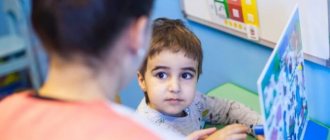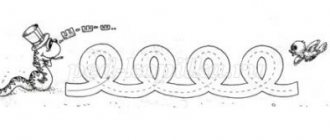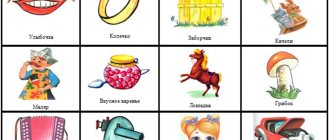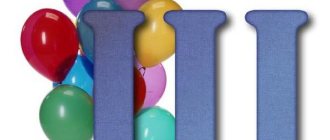Features of articulation
The problem of incorrect sound pronunciation (if the child does not have other speech problems, for example, dysarthria) of sonorant sounds is the difficulty in their articulation. This is especially true for R, so speech therapists advise parents not to panic if their child does not “growl” at three years old. The articulatory apparatus must be prepared, which happens by the age of 4-5, so be sure to do articulatory gymnastics with your child.
When pronouncing P, the organs of the articulatory apparatus occupy the following position:
- the mouth is open, the lips are in the position of the vowel sound following P;
- the tongue should be wide, located behind the upper teeth and touching the alveoli, the lateral edges should be raised; it is shaped like a small ladle;
- the soft palate is raised;
- vocal cords vibrate.
In addition to the correct position of the organs of the articulatory apparatus, a strong air stream is needed, because when exhaling it is directed to the tip of the tongue, resulting in its vibration and a “rumbling” sound.
The tip of the tongue should vibrate, not the small tongue or its side. You can check the direction of the air stream using a strip of paper: if pronounced correctly, it will sway.
Types of violations
Violation of the pronunciation of the sounds R and R` is called rhotacism and pararotacism.
There are several options:
- Absence of sound in speech - the child does not use another sound instead (for example, “cow” instead of “cow”).
- Velar - occurs when the back of the back of the tongue rises too much and comes into contact with the soft palate. As a result, a gap is formed and when air passes through it, the walls of the sky create additional noise, which distorts the pronunciation of sound. This disorder is called burr.
- Uvular - only the small tongue vibrates. This type of rotacism is called throat rhotacism.
- Side – the side edge vibrates. When pronounced, the sounds R and L` are combined.
- Bilibial - this type of disorder is rare. The child creates a vibration with his lips and produces a sound similar to “prrr”.
- Labiodental - the sound is produced between the upper lip and lower teeth, and vice versa.
- Single-beat or proto sound - the tip of the tongue makes only one blow on the alveoli, and long vibrations are not obtained. The pronounced sound has a D sound; the child cannot pronounce the long, rolling R.
- Buccal - the air stream passes through the cheek and lateral edges of the tongue, which causes vibration of the cheeks.
- Interdental - the tongue is located between the teeth.
- Laryngeal - the sound P occurs as a result of strong tension of the vocal cords.
Pararotacism is the replacement of one sound with another. The sound R is often replaced with its soft version, or replaced with L, which is simpler in articulation.
This sound is also replaced by the following sounds:
- B - “pavahod” instead of “parachod”;
- D – “duca” instead of “hand”;
- G – “pagavoz” instead of “paravoz”;
- Y – “yiba” instead of “fish”.
Rhotacism may be a reflection of simple dyslalia, when the pronunciation of one sound is impaired. Or is it a variant of complex dyslalia, when the sound pronunciation of several groups of sounds is impaired. Rotacism and pararotacism may indicate more complex speech disorders - dysarthria, alalia, rhinolalia.
Reasons for violations
Why does a child have a problem with the pronunciation of R? There are several reasons, and to eliminate some of them you need the help of several specialists, not just a speech therapist:
- Anatomical features. These include a shortened hyoid frenulum, cleft lip, palate, and malocclusion.
- The air stream is not strong enough.
- Incorrect position of the organs of articulation - there are no anatomical disorders, but, for example, the tongue is in the wrong position because the child did not remember the correct articulation.
- Incorrect speech environment - often parents worry that if they burr, then their children will pronounce R incorrectly. This is not a genetic predisposition, but an incorrect speech environment. The child hears the incorrect pronunciation and tries to copy it. This is why rotacism arises.
- The child does not distinguish sounds by ear - this is a violation of the phonetic processes.
In addition, if there is a complex speech disorder - alalia, then incorrect sound pronunciation may be a consequence of insufficient activity of the speech areas of the brain. It is important to determine the exact cause of rhotacism and pararotacism in order to draw up a plan for corrective work.
Speech therapy diagnostics
To determine whether there is a violation of the sonorous group, you need to select speech material. But the examination begins with checking the articulatory apparatus. The specialist pays attention to their anatomical structure. Then evaluates the work using exercises (for example, raising and lowering the tongue).
The speech therapist checks speech breathing. To do this, he asks the child to play wind instruments (pipes); blow on a piece of cotton wool. Thus, the specialist watches how the child inhales and exhales and the force of exhalation.
The sound R must be present in forward and backward syllables, at the beginning, middle and end of the word. You also need to select syllables with a combination of consonants (for example, TRA, KRA and others). It happens that a child can pronounce R and R` paired with consonants - it is important to reflect such moments in speech therapy diagnostics.
You also need to check phonetic processes: the speech therapist calls the child isolated sounds and asks him to clap his hands or raise his hand to the desired sound. Then they also check P in syllables and words. The speech therapist shows the child pictures and asks to see the image that has R in the name.
In addition to speech diagnostics, the specialist conducts a conversation with parents to understand the environment in which the child is growing up. Because if there are adults around who burr or have other types of rhotacism and pararotacism, they need to correct their speech when communicating with him, try to use fewer words with the corrected sound.
Based on all the collected data, the speech therapist draws up correctional work. If necessary, he advises you to contact other specialists to get comprehensive help and achieve results.
Breathing exercises
Breathing speech therapy gymnastics:
- "Bubbles." Take a deep breath through your nose, puff out your cheeks and exhale through your mouth.
- "Mill". Feet together, arms up. Rotate with straight arms, saying “zh-r-r” as you exhale. Speed up movements, increase sound.
- "Geese." Walk around the room, flapping your arms like wings. Raise your arms as you inhale, lower them as you exhale, saying “g-oo-oo.”
- "Balloon". Lying on your back, place your hand on your stomach. Take a deep breath and exhale, observing the movement of your hand. Inflate your belly like a balloon.
- "Hedgehog". Imitation of a hedgehog puffing with tension in the muscles of the nasopharynx.
What specialist help may be needed?
If the cause of a speech defect in a child is a shortened hyoid frenulum, then consultation with a surgeon may be required. But in modern speech therapy they solve this problem with the help of exercises. And only those who have a too short frenulum need the help of a surgeon. This defect makes it difficult to raise the tongue, which is the basis for the pronunciation of R.
If your bite is incorrect, your speech therapist may advise you to see an orthodontist. If there is a complex speech disorder (dysarthria, alalia), to activate speech processes you need a special course of treatment, which is selected by a neurologist. As well as a consultation with a defectologist who can draw up a plan for corrective work on the development of the emotional-volitional sphere.
Preparatory stage
Р and Р` are complex sounds, so before you start playing them, you need to do some preparatory work. This stage is based on articulatory gymnastics and includes exercises for the tongue. Exercises should be static (holding a certain position) and dynamic:
- "Smile". The lips are stretched in a smile, the teeth are together, the tongue is at the bottom.
- "Window". The mouth is open, the lips are in the same position as when pronouncing O, tongue down.
- "Fence". The lips are shaped like a square (as when pronouncing Ш), the teeth are together, the tongue is below.
- "Tube". The lips are pulled forward, the mouth is slightly open, the tongue is in the same position as in previous tasks.
- "Spatula". The mouth is open, place a wide, relaxed tongue on the lower lip and hold in this position.
- "Needle." The mouth is open, you should try to reach the chin with your tongue, and it should be narrow.
- "Swing". The lips are smiling, the tongue is narrow and needs to be raised and lowered.
- "Watch." The lips are in the same position, only the tongue needs to be moved left and right.
- "Cup". The child is smiling, place a wide tongue on the lower lip. Then lift the tip of the tongue and its side edges. It should form a “cup” and hold it in this position.
These were basic exercises that prepare the organs of the articulatory apparatus for producing sound. Static exercises should be held for 10-15 seconds. You need to start with a small number of repetitions, up to 3, gradually increasing them to 5-7.
After the basic exercises, you can move on to the tasks that are needed to prepare your apparatus specifically for pronouncing a sonorous group:
- “Brushing the upper teeth.” The lips smile, with the wide tip of the tongue you need to imitate the movements as when using a toothbrush. And thus “clean” your upper teeth.
- "Clearing the sky." You need to make forward and backward movements with your wide tongue.
- "Fungus". The child should suck his tongue to the roof of his mouth. This exercise is not easy, so to simplify the task, you can ask to hold caramel or ascorbic acid.
- "Harmonic". The organs of articulation are in the “Mushroom” position. The lower jaw moves up and down - it turns out to be an accordion.
- "Horse". The child imitates the clatter of hooves. The tongue should be wide when performing the exercise.
- "Drummer". Repeating the sound D several times. Lips in a smiling position. Please note that the sound should be clean and clear, no sensing.
- "Turkey". The wide tongue needs to be fixed on the upper lip. Move it back and forth, “stroking.” And when performing, add a voice and a combination of BL sounds.
These exercises are aimed at preparing for the production of P and P`. This complex of articulatory gymnastics helps the child master correct pronunciation. And it can and should be done, even if there are no speech disorders. Then, by the age of four or five, the child will pronounce sounds correctly.
In addition to articulatory gymnastics, they work on the formation of speech breathing; it should be diaphragmatic. Inhale through the nose, exhale through the mouth. The specialist invites the child to feel the work of the diaphragm; he places his hand on this area.
Invite your child to play the game “Kick the ball into the goal.” To do this you will need two small pieces of cotton wool, place glasses that will serve as gates. Compete to see who can hit a cotton wool ball into the goal. Make sure that the child inhales through the nose and does not puff out his cheeks when exhaling. This exercise is aimed at creating a strong exhalation.
In speech therapy classes on production and in the first stages of automation, performing this set of exercises for articulation and breathing is mandatory. Why can these tasks be skipped at later stages of automation and differentiation? Because in these classes more attention is paid to consolidating sound in coherent speech and developing phonetic processes.
Preparation of the articulatory apparatus
In correctional classes, the preparatory stage is devoted to working with the articulatory apparatus. Exercises are performed to stretch the hyoid ligament, lift the tongue upward, and warm up the lips and jaw.
Tasks for preparing the articulatory apparatus for work:
- “Swing” - open your mouth, stretch your tongue alternately to your nose and chin.
- “Horse” - click your tongue slowly and forcefully, imitating the sound of a horse’s hooves, while the lower jaw remains motionless.
- “Chatter” - use the wide tip of your tongue to run back and forth along your upper lip, without lifting your tongue. Simultaneously say “BL-BL-BL”.
Staging methods
Correction needs to be done in stages. After the preparatory work comes the staging stage.
There are several ways you can practice at home:
- From the “Mushroom” exercise. When the tongue is in the desired position, the child exhales forcefully onto the tip of the tongue. The result is vibration. For this method, the child must be able to exhale forcefully.
- Mechanical or "Chatterbox". For this method, you can use a ball probe, but at home, parents can use a cotton swab. The child performs the “Drummer” exercise, while the adult places the tip of a cotton swab under the tongue and makes oscillatory movements from side to side. You will get a combination of DR. But be sure to make sure that the D sound in the exercise is clear. For convenience, the child can be in a lying position.
- From a combination of healthy lifestyles. The wide tongue is raised by the upper teeth and the child pronounces the ZZ for a long time. He feels a slight vibration and with a stronger exhalation he will get R.
These are the most popular ways to create a sonorous sound yourself at home. In children with normal speech development, this sound appears through onomatopoeia. Provided that his articulatory apparatus is prepared. By the age of five years, a child should clearly pronounce all groups of sounds.
Gymnastics for lips
The complex includes 3 exercises:
- "Let's smile!" The baby smiles, showing all his teeth. The duration of the approach is 5 seconds.
- "Tube". There are 2 variations of this exercise. The student stretches out his lips, imitating a tube, silently “reproduces” the sound “u” or closes his teeth and slightly stretches his lips forward so that a square is formed.
- "The doors are opening." The baby slowly opens his mouth so that there is a distance of 10 mm between the teeth of both jaws.
Then he smiles, showing his teeth.
Possible difficulties during installation
You should not automate sound in speech if the articulatory apparatus is not sufficiently prepared. Even if you manage to mechanically deliver P, then due to the weak tone of the tongue in speech, the tongue will “slip” and you will get a distorted sound. If the child does not have a strong air stream, the vibration will not be pronounced enough, which also leads to incorrect sound pronunciation.
If the isolated sound is unclear, there is no need to automate it. The child will remember the incorrect pronunciation (namely the organs of articulation) and then it will be more difficult to correct. And distorted pronunciation of R can lead to problems when reading and writing. Therefore, for preschoolers of the senior and preparatory groups, include exercises for the letter R in your classes.
Do not confuse the concepts of “sound” and “letter”. We hear sounds, but we see letters. You are engaged in production and automation of sound, and in reading and writing lessons you study letters.
Some parents do not pay attention to the hyoid frenulum. And sometimes it is precisely because of this that the child has difficulties with sound production. If it is short, do exercises to stretch it (“Mushroom”, “Accordion”). If parents have rhoticism, then only a speech therapist or an adult with correct pronunciation should conduct classes. For effective classes, you need to create suitable conditions and select exercises for the sound R. Then the correction work will be more successful.
Drawing up a correction program
It depends on the form of the sound pronunciation disorder. For example, a child may have no vibrant in his speech at all, or he may replace it with other sounds or mix them. Rotacisms, that is, distortions, are also common. There are 8 types of rotacisms. Therefore, the speech therapist selects a step-by-step production of the sound “r” individually for each little patient. However, there is a list of exercises that are suitable for any form of vibrant pronunciation disorder.
“Imitation” technique for simple cases
The staging exercise involves auditory perception of sound. The little student is offered examples of phonemes, for example, the roar of a motor, thunder. And he, sitting in front of the mirror, repeats what he heard.
Audio Automation Recommendations
As soon as the child manages to pronounce R, begin his automation in syllables. Before doing this, practice making a long, rolling sound, let your tongue get used to the feeling of vibration. Usually, correct pronunciation is reinforced in straight syllables (RA, RO, RU), but in the case of the sound P, some children find it easier when it is in a solid position, and not when the organs of articulation occupy the position of the subsequent vowel.
At the stage of consolidation in syllables, use syllabic paths and pure phrases. Proceed with consolidation in words only when the child confidently pronounces R in syllables. Offer the following tasks: come up with words for this sound, name all the objects, for example, in the room, that have this sound. To practice correct pronunciation in phrases, short poems are suitable; you can compose phrases from the proposed words, tongue twisters.
Then comes automation in sentences and coherent speech. The child can compose stories based on the picture, from the proposed list of words. An adult can come up with a fairy tale about the sound R and invite the child to retell it. At the same time, you need to work on correlating the sound with the letter: write the letter P, lay it out from available materials.
At the beginning of the automation stage in tasks, speech material should be saturated with the sound R. The organs of articulation must remember the correct position during pronunciation, and the child fixes its correct sound in speech. Also, in speech therapy exercises for the sound R, at the very beginning of reinforcement, the adult pronounces it together with the child, then the child repeats it. And then the speech therapist or parents ask him to say it himself. When selecting speech material, do not use words using the soft version of R and the sounds L and L`. Speech material must correspond to children's perception.
Bogomolova method
A.I. Bogomolova in 1979 proposed a method for generating vibration for saying “R”. The teeth are open to a distance of 2 fingers. The tongue is pressed against the palate, stretching the frenulum as much as possible. The teacher moves the edges of the tongue towards the palate with his fingers, while the frenulum is free.
The child takes a deep breath and blows it out sharply, using his voice. The combination “TZ” is formed. Repeat the exercise, gradually increasing the air pressure. The sound combination “TLE” will change to “TR”. After fixing the short “TR”, they practice the rolling “TR” with the help of fingers, and then without them.
Duration of correctional work
How long does it take to develop the correct pronunciation of the sound R? In modern speech therapy there are no clear time boundaries. This applies to working with any group of sounds. It all depends on the individual characteristics of the child. You can install sound already in the first lessons (if preparatory work has been done), but the automation stage can take quite a long time.
The sound R is complex in articulation, which is why it appears in speech at an older age. There is no need to rush into automation; your task is to achieve clear sound and stable vibration. The tongue should not “slip” when the child pronounces words. To make it interesting for him, use didactic games, and not just verbal and visual material.
You can look for a specific speech therapy technique, but they are all built on the principles and practical tips outlined above. The main condition for successful correctional work is diagnosis and correctional work taking into account the individual characteristics of the child.
What prevents you from pronouncing R?
The articulation of this phoneme is the most complex in Russian speech. For correct sound, clear movements of the speech apparatus are required, which are quite difficult for children. To make their task easier, children “swallow” the phoneme in words, replace it with the sounds “L” and “Y” that are simpler in terms of articulation, or use glottal phonation.
Causes of the problem:
- pathological bite;
- speech breathing defect;
- underdevelopment of the lingual frenulum;
- weakness of the facial muscles;
- distorted perception of sounds.
Staging is assigned when the sound “R”:
- is missed in words;
- replaced by the phonemes “L” and “Y”;
- softens where it should be hard.






